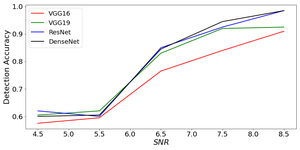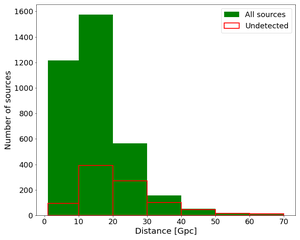
The first direct detection of gravitational waves (GWs) by the two LaserInterferometer Gravitational-wave Observatory (LIGO) detectors has opened a new era of multimessenger astrophysics. Vast amount of data is expected to be delivered from the upcoming third generation detectors such as the Einstein Telescope (ET). The ET will have a better sensitivity of one order of magnitude which will allow the detection at lower frequency, where 105 − 106 and 7 × 104 of Binary Black Holes (BBHs) and Binary Neutron Stars (BNs) respectively are expected to be detected annually.
Detection of GW signals are traditionally done through the analysis of a hidden signal in the raw data from the detector, so-called matched filtering. Matched filtering process compares modeled waveform templates with the raw data. The main disadvantage of match filtering is that it depends entirely on the availability of waveform templates. This process is computationally challenging, and depends also on the accuracy of the modeled waveforms.
Once a signal is detected, the subsequent step is to estimate its parameters, for which as many as 107 waveform templates are required for an accurate estimation. Deep Learning (DL) is a promising alternative for GW data analysis, both for detection and parameter estimation. This goes back to its flexibility in categorizing and modeling patterns read from data, with very little human input. In contrast to match filtering search method, DL models can learn to distinguish between only noise and injected noise (noise plus signal) without the need to model every possible GW waveform. This is done through learning the underlying features of pure noise and injected noise, which gives DL an advantage over the traditional methods, where no matching is involved. The Convolutional Neural Networks (CNNs) is one of the most popular DL models, which primarily designed to take advantage of the 2D structure of an input image (or other 2D input such as a speech signal) to solve complex tasks such as pattern recognition and object detection.
In a recent paper "Detection of Einstein Telescope gravitational wave signals from binary black holes using deep learning", authors: Wathela Alhassan, Tomasz Bulik (Copernicus Astronomical Center in Warsaw/AstroCeNT) and Mariusz Suchenek (Warsaw University Observatory) explored the efficiency of using CNNs for the detection of BBHs’ mergers with luminosity distance up to 120 Gpc and component masses ranging from 15 to 56 solar mass. Synthetic signals buried in gaussian noise were generated according to ET’s parameters. Without performing data whitening or applying bandpass filtering, we trained four CNN networks with the state-of-the-art performance in computer vision, namely VGG, ResNet and DenseNet, on Time-frequency representations of pure noise and injected. ResNet has significantly better performance, and was able to detect BBHs sources with SNR of 8 or higher with 98.5% accuracy, and with 92.5%, 85%, 60% and 62% accuracy for sources with SNR range of 7-8, 6-7, 5-6 and 4-5 respectively. ResNet, in qualitative evaluation, was able to detect a BBH’s merger at 60 Gpc with 4.3 SNR. It was also shown that CNN can be used efficiently for near-real time detection of BBHs.
Figure 1, at the top: SNR versus detection’s accuracy.

Figure 2: Luminosity distance of the all BBHs sources and the undetected ones.
Text: Wathela Alhassan






